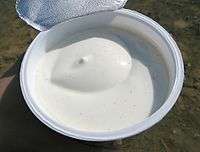Skyr

Skyr (Icelandic pronunciation: [ˈscɪːr̥], English /ˈskɪər/ SKEER) is an Icelandic cultured dairy product. It has the consistency of strained yogurt but a much milder flavor. It has been a part of Icelandic cuisine for over a thousand years.[1] It is traditionally served cold with milk and a topping of sugar.[2]
History
Skyr was brought from Norway to Iceland more than 1100 years ago, and though the tradition died out in most of Scandinavia, it lived on in Icelandic culture, and parts of Norway. Skyr is mentioned in a number of medieval Icelandic sources, including Egil's saga and Grettis saga. It is unclear how similar this was to modern-day skyr, as no detailed descriptions of skyr exist from this period. Culinary historian Hallgerður Gísladóttir has suggested that skyr was known throughout Scandinavia at the time of the settlement of Iceland but eventually forgotten outside of Iceland.[3]
Traditionally, skyr is made with raw milk; however, modern skyr is made with pasteurized skimmed milk. A small portion of skyr is added to the warm milk, to introduce the right bacteria, such as Streptococcus salivarius subsp. thermophilus and Lactobacillus delbrueckii subsp. bulgaricus. Rennet is sometimes added as well, and the milk is left to coagulate. The skyr is then strained through fabric to remove the whey (mysa in Icelandic) and the milk solids retained.
Skyr has a slightly sour dairy flavour, with a hint of residual sweetness. Commercial Icelandic manufacturers of skyr have added flavours such as vanilla, berries, etc. common to yogurt to the final product, to increase its appeal.
Availability
Skyr is a popular product in Iceland and is sold by Siggi's Dairy in parts of the United States.[4] Skyr can also be purchased in Austria, UK, Ireland, Germany, Belgium, the Netherlands, Switzerland, Nordic countries (including the Faroe Islands and Greenland), The Baltic states and Canada.
The President's Choice brand is available in the Netherlands and since 2015 in Canada. Thise Mejeri in Denmark has produced skyr since May 2007. A licensed version produced by Q-meieriene is available in Norway since 2009,[5] Sweden since 2011 and Finland since 2013.
Skyr is produced in Iceland by MS Iceland Dairies [6] (Mjólkursamsalan) who claim theirs is "the only product made with Original Icelandic Skyr Cultures". It is available in Denmark since 2007, Iceland, Ireland since September 2015[7] Finland since 2009, Norway since 2009, Sweden since 2012, Switzerland since 2014, the US[8] and in the UK[9] since February 2016.
Since 2015, "Icelandic-style skyr" has been produced by the Swedish/Danish cooperative Arla in the Netherlands and Germany and sold there, in Denmark and in the UK.[10] Arla is banned from selling under the name "skyr" in Finland where only MS Iceland Dairies can use the trademarked name.[11] In Latvia, skyr is produced by Tukuma Piens under the brand "Baltais".[12] In Lithuania, Skyr is produced by Varėnos Pienelis under brand Aistė.[13][14]
Nutrition
Skyr is a high protein, low-fat product, varying slightly between brands. Unflavored skyr is roughly 12% protein, 3% carbohydrate, and 0.5% fat. It is high in calcium and vitamins commonly found in milk products.[15]
Uses
Skyr may be used in a traditional Icelandic dish called hræringur (meaning "stirred" or "made by stirring") which consists of roughly equal amounts of skyr and porridge. It is often mixed with jam or fruit for a dessert, with prepared fish for dinner, or with cereals for breakfast.[16] Contemporary uses include using skyr as a cheesecake topping [17] and as an ingredient in fruit smoothies.[18]
In Norway today, skyr is also used as a term for other variants of cultured milk products – usually byproducts from cheese production. In its traditional use, it was diluted with water when used as a beverage, or mixed with milk and crumbs of flatbread as a quick meal.
See also
- Filmjölk – another Nordic cultured milk product
References
- ↑ Guðmundur Guðmundsson. "Hnigfræði og smásæ bygging skyrs: Abstract" (in Icelandic and English). Retrieved 25 April 2012.
- ↑ "Favorite Recipes Gleaned From Menus of Many Foreign Nations". The Evening Independent. 23 July 1926. p. 14. Retrieved 9 September 2012.
- ↑ Hallgerður Gísladóttir (1999). Íslensk matarhefð (in Icelandic). Reykjavík: Mál og menning. p. 73. ISBN 9979-3-1846-5.
- ↑ "The Yogurt Chronicles: Siggi's builds a niche market from an ancient Icelandic yogurt recipe". Slate Magazine. Retrieved 9 May 2015.
- ↑ Q-Meieriene article about Skyr
- ↑ "Icelandic skyr, low-fat dairy product unique to Iceland, with health benefits".
- ↑ "Now you can buy the Icelandic skyr in Ireland"
- ↑ Where to buy skyr in the US? Find Iceland's yogurt Skyr in Whole Foods markets
- ↑ "Icelandic skyr - low-fat dairy product with health benefits".
- ↑ "Arla skyr - the Icelandic super yogurt". arla.com. Retrieved 16 June 2015.
- ↑ Swedish Arla banned from selling skyr in Finland. Iceland Magazine
- ↑ "Skyr Islandes jogurts bezpiedevu, 400 g". baltais.lv. Retrieved 9 May 2015.
- ↑ "Aistė".
- ↑ Gabaglio. "Skyr in der Schweiz". gabaglio.com. Retrieved 9 May 2015.
- ↑ Nutritional facts: http://www.skyriceland.com/skyr.is-products
- ↑ A hræringur recipe: http://caloriecount.about.com/hrringur-56-recipe-r702104
- ↑ Icelandic Skyr & Blueberry Cake
- ↑ Yogurt recipes with Skyr, the healthy Icelandic yogurt
External links
| Wikimedia Commons has media related to Skyr. |
- Food-Info article on skyr
- Iceland woos America with lamb and skyr – NY Times article (18 October 2005) on Whole Foods introducing skyr to the US